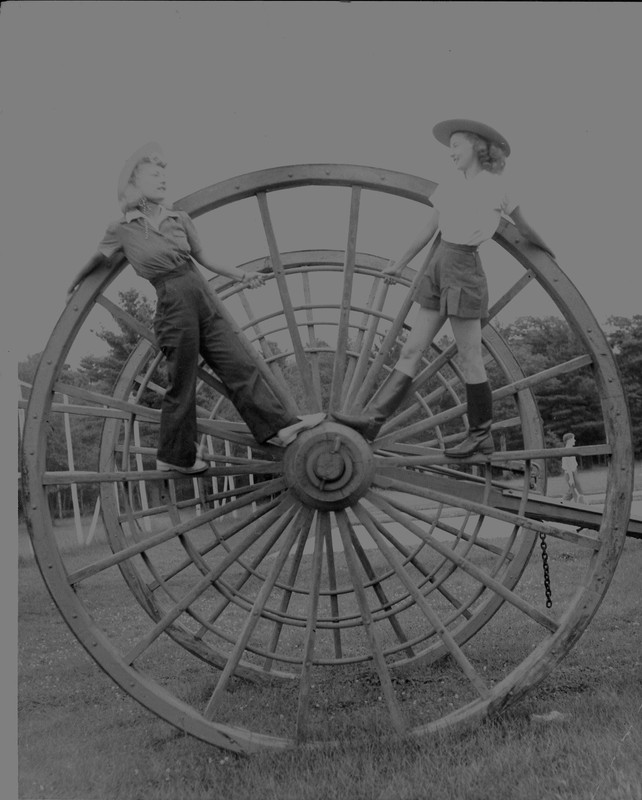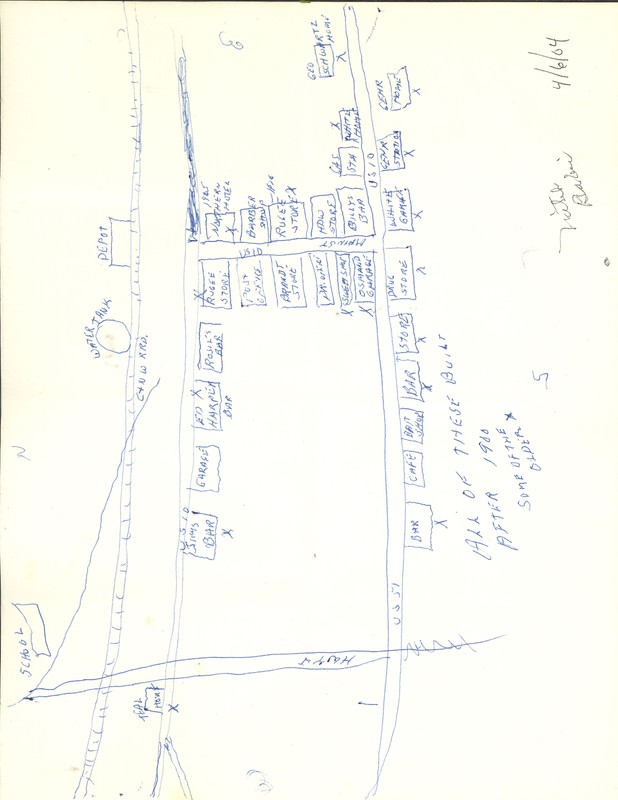Historic Sites and Sights of Mercer
Introduction
Author-Uploaded Audio
Listen to a narration of this entry's description by Mercer Library.
Text-to-speech Audio
The Mercer Library is part of an ongoing project with the Northern Wisconsin Heritage Council. Local library staff and volunteers are involved in documenting and researching local history and presenting it in a way which the public can view and enjoy. These sites have been chosen to spotlight important and interesting historical places and events. Many can be reached on foot from the 'downtown' Mercer area, others are within a drivable distance of each other, and still others are reachable from the water. People who wish to share their own insights, knowledge or documentation are encouraged to contact the Mercer Library. Audio is of Mitch Babic from a cassette tape and given to the Mercer Area Historical Society housed in the Mercer Library.
Images
Girls posing on a "Godevil", two giant wheels on an axel that was yoked to oxen or horses. Logs were chained to it and dragged out of the woods.

Map drawn from memory by Mitch Babic, early and longtime Mercer Resident.

Backstory and Context
Text-to-speech Audio
The recorded history of Mercer, Wisconsin can be traced back to 'Turtle Village', which on old maps indicate seasonal Native American occupancy. Early accounts indicate a residence and garden areas near Grande Portage Lake and the current Carow Park, and a Sugar Bush, sapping operation. Fur traders would know this spot as "6-Pause(Pose) Portage", an important stop along the trade route known as the Flambeau Trail. The Flambeau Trail ran from the mouth of the Montreal river, upstream adjacent to the river, until the trail took an easterly turn that led to Long Lake. From Long Lake they could travel down through the chain of lakes to present day Mercer. From here they could portage to the Manitowish River and travel further onto Lac Du Flambeau. European pioneers would later settle the land in the 1800's. The railroad arrived in the 1880's and served local timber operations like Shea, Ed Staple and the Hanneman Lumber Company.
The new means of transportation open up the area to travel. Soon settlers and tourists rode the rail all the way to Mercer. Over time the area would be known by many names such as Pig Town, Swede Town and Coffee Mill. In 1908, when the first board meeting was held to elect officers and the name was finalized as Mercer, after prominent lumberman, John Mercer. As the lumber boom died down, the tourism industry grew and many people from far away began what would become a generations long tradition of vacationing in the Northwoods.
The Federal Works Progress Administration enlisted authors through the Federal Writers Project to write a book called “The WPA Guide to Wisconsin” in the 1930s. The trip to and through Mercer is described as;
“..., at the Northern entrance to Wisconsin’s famed Northern Lakes Region, still retains a relic of logging days, a Go-Devil. These go-devils consisted of two huge, 10-foot wheels on a great axel, drawn by oxen or horses. Heavy logs were chained under the axel and “snaked” out of the woods to be “decked” by the roadside. Now the logs are “snaked” out by a tractor or a gasoline-motor winch.
South of Mercer US 51 enters the Northern Lakes Region, which in ratio of water to land surface is parallel only by two other places: one includes part of Minnesota and the Province of Ontario, northwest of Lake Superior; the others includes part of southern Finland, east of the Gulf of Bothnia. In Iron, Vilas and Oneida Counties alone, lakes comprise 15 per cent of the total area, swamps an additional 21 per cent. Shaped as irregularly as ink blots, the lakes range in size from a few acres to several square miles. On the shores of some are sophisticated summer resorts; elevated dance halls, taverns, and luxurious private homes set in heavy forest strike a strangely discordant note. Almost all lakes contain game fish native to Wisconsin-walleyed and northern pike, muskellunge, black and rock bass, perch and sunfish.”
Since its founding Mercer has been known for its colorful cast of characters including Fur Traders, Hermits, Lumberjacks, Moonshiners and Mobsters. These sites have been painstakingly researched for accuracy. More entries will be added as current ones are updated with new information. Many are on private property and we encourage everyone to be respectful when visiting these sites. For questions, please feel free to stop in at the Mercer Public Library. Listen to attached audio for a personal account from Mitch Babic about the early days of Mercer.
Sources
Mercer Area Historical Society. Mercer Remembers...Pictures & Stories of its Past. Mercer, WI. 54547.
Federal Writers' Project. The WPA Guide to Wisconsin. Edition 2006. St. Paul, MN. Minnesota Historical Press, 1941.
Harper, Harper Wesley. One of the Oldest of "Old-Timers". 1986.
Taped Interview with Mitch Babic, Sept 2003. Given to the Mercer Area Historical Society and archived by the Mercer Library.
"After the Timber, Community History of Mercer Emphasizes Recreation and Tourism." Iron County Miner (Hurley) June 22nd, 1993. Iron County Centennial ed, 8-8.
Mercer Area Historial Society Records at the Mercer Public Library
Mercer Area Historial Society Records at the Mercer Public Library, Mitch Babic Collection
